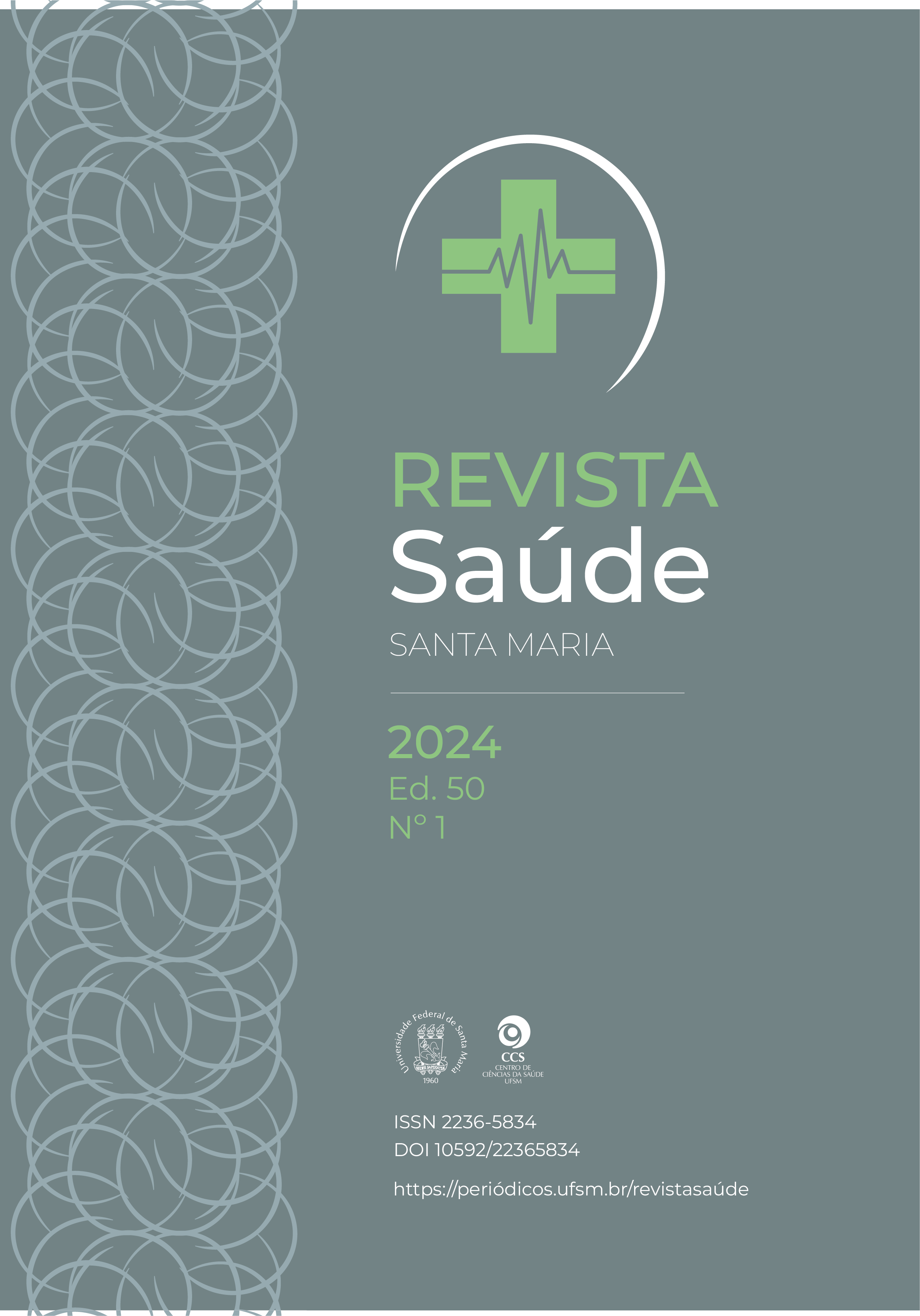Clinical and economic impact of Antimicrobial Stewardship Program in a school hospital in Brazil
DOI:
https://doi.org/10.5902/2236583467943Keywords:
Agentes Anti-infecciosos, Serviço de Farmácia Clínica, Redução de Custos, Serviços de Controle de Infecção Hospitalar,Abstract
Antimicrobials are one of the most prescribed drug classes in hospital environments, generating high health costs, in addition to being co-responsible for bacterial resistance. This study aimed to evaluate the clinical and economic impacts of the Antimicrobial Stewardship Program in a school hospital in the hinterland of Rio Grande do Sul, Brazil. Methods: Antimicrobials were analyzed according to their indication, dose, duration of treatment, and route of administration. Whenever needed, interventions with the prescribing physician or nursing staff were performed to optimize the therapy. Results: A total of 1288 medical prescriptions underwent pharmaceutical analysis. It was carried out 71 interventions, including interventions with medical staff and nursing staff, with an acceptance rate of 75% and 100%, respectively. The cost savings achieved during the study period (5 months) was R$ 5,921.84. The vast majority of patients in the intervention group had a positive outcome, progressing to discharge (86.96%). There was an 18.3% reduction in the Daily Defined Dose of intravenous ciprofloxacin between May and July. Conclusion: This study highlights the positive aspects of using the Antimicrobial Stewardship Program as an effective strategy in reducing costs and consuming antimicrobials without negative impacts on patients’ clinical outcomes.
Downloads
References
Versporten, A. et al. Antimicrobial consumption and resistance in adult hospital inpatients in 53 countries: results of an internet-based global point prevalence survey. Lancet Glob. Heal. 6, e619–e629 (2018). http://dx.doi.org/10.1016/S2214-109x(18)30186-4. DOI: https://doi.org/10.1016/S2214-109X(18)30186-4
Bozkurt, F. et al. Analysis of antimicrobial consumption and cost in a teaching hospital. J. Infect. Public Health 7, 161–169 (2014). http://dx.doi.org/10.1016/j.jiph.2013.09.007. DOI: https://doi.org/10.1016/j.jiph.2013.09.007
Kiguba, R., Karamagi, C. & Bird, S. M. Extensive antibiotic prescription rate among hospitalized patients in Uganda: But with frequent missed-dose days. J. Antimicrob. Chemother. 71, 1697–1706 (2016). http://dx.doi.org/10.1093/jac/dkw025. DOI: https://doi.org/10.1093/jac/dkw025
Nathwani, Dilip (Ninewells Hospital and Medical School, D. Overview of Antimicrobial Resistance. Antimicrobial Stewardship From Principles To Practice (2018). https://ameci.org.br/wp-content/uploads/2018/10/BSAC-AntimicrobialStewardship-FromPrinciplestoPractice-eBook.pdf.
Carneiro, M. et al. O uso de antimicrobianos em um hospital de ensino: uma breve avaliação. Rev. Assoc. Med. Bras. 57, 421–424 (2011). http://dx.doi.org/10.1590/S0104-42302011000400016. DOI: https://doi.org/10.1590/S0104-42302011000400016
Garau, J. & Bassetti, M. Role of pharmacists in antimicrobial stewardship programmes. Int. J. Clin. Pharm. (2018) http://dx.doi.org/doi:10.1007/s11096-018-0675-z. DOI: https://doi.org/10.1007/s11096-018-0675-z
Tünger, Ö., Dinç, G., Özbakkaloglu, B., Atman, Ü. C. & Algün, Ü. Evaluation of rational antibiotic use. Int. J. Antimicrob. Agents 15, 131–135 (2000). http://dx.doi.org/10.1016/s0924-8579(00)00158-8. DOI: https://doi.org/10.1016/S0924-8579(00)00158-8
Ingram, P. R., Seet, J. M., Budgeon, C. A. & Murray, R. Point-prevalence study of inappropriate antibiotic use at a tertiary Australian hospital. Intern. Med. J. 42, 719–721 (2012). http://dx.doi.org/doi:10.1111/j.1445-5994.2012.02809.x. DOI: https://doi.org/10.1111/j.1445-5994.2012.02809.x
Owens, R. C. Antimicrobial stewardship: concepts and strategies in the 21st century. Diagn. Microbiol. Infect. Dis. 61, 110–128 (2008). http://dx.doi.org/doi:10.1016/j.diagmicrobio.2008.02.012 DOI: https://doi.org/10.1016/j.diagmicrobio.2008.02.012
Mendelson, M., Morris, A. M., Thursky, K. & Pulcini, C. How to start an antimicrobial stewardship programme in a hospital. Clin. Microbiol. Infect. 26, 447–453 (2020). https://dx.doi.org/10.1016/j.cmi.2019.08.007. DOI: https://doi.org/10.1016/j.cmi.2019.08.007
Parente, D. M. & Morton, J. Role of the Pharmacist in Antimicrobial Stewardship. Med. Clin. NA 102, 929–936 (2018). https://dx.doi.org/10.1016/j.mcna.2018.05.009 DOI: https://doi.org/10.1016/j.mcna.2018.05.009
Chang, Y. Y. et al. Implementation and outcomes of an antimicrobial stewardship program: Effectiveness of education. J. Chinese Med. Assoc. 80, 353–359 (2017). http://dx.doi.org/10.1016/j.jcma.2016.09.012. DOI: https://doi.org/10.1016/j.jcma.2016.09.012
Apisarnthanarak, A., Lapcharoen, P., Vanichkul, P., Srisaeng-Ngoen, T. & Mundy, L. M. Design and analysis of a pharmacist-enhanced antimicrobial stewardship program in Thailand. Am. J. Infect. Control 43, 956–959 (2015). http://dx.doi.org/10.1016/j.ajic.2015.05.011. DOI: https://doi.org/10.1016/j.ajic.2015.05.011
SHEA, S. for H. E. of A., IDSA, I. D. S. of A. & PIDS, P. I. D. S. Policy Statement on Antimicrobial Stewardship by the Society for Healthcare Epidemiology of America (SHEA), the Infectious Diseases Society of America (IDSA), and the Pediatric Infectious Diseases Society (PIDS). Infect. Control Hosp. Epidemiol. 33, 322–327 (2012). http://dx.doi.org/10.1086/665010. DOI: https://doi.org/10.1086/665010
ANVISA, A. N. de V. S. Nota Técnica GVIMS-GGTES no 05-2017 REVISADA: Orientações para a notificação nacional das Infecções Relacionadas à Assistência à Saúde (IRAS), Resistência Microbiana (RM) e monitoramento do consumo de antimicrobianos. (2018). https://www.gov.br/anvisa/pt-br/centraisdeconteudo/publicacoes/servicosdesaude/notas-tecnicas/nota-tecnica-gvims-ggtes-no-05-2017-revisada.pdf/view.
Li, Z. et al. Pharmacist-driven antimicrobial stewardship in intensive care units in East China: A multicenter prospective cohort study. Am. J. Infect. Control 45, 983–989 (2017). http://dx.doi.org/10.1016/j.ajic.2017.02.021. DOI: https://doi.org/10.1016/j.ajic.2017.02.021
Bartlett, J. M. & Siola, P. L. Implementation and first-year results of an antimicrobial stewardship program at a community hospital. Am. J. Heal. Pharm. 71, 943–949 (2014). http://dx.doi.org/10.2146/ajhp130602. DOI: https://doi.org/10.2146/ajhp130602
Holguín, H., Amariles, P., Ospina, W., Pinzón, M. & Granados, J. Intervenciones farmacéuticas y desenlaces clínicos en un programa de gerenciamiento de antimicrobianos. Rev. Chil. infectología 37, 343–348 (2020). http://dx.doi.org/10.4067/S0716-10182020000400343. DOI: https://doi.org/10.4067/S0716-10182020000400343
Kamarudin, G., Penm, J., Chaar, B. & Moles, R. Educational interventions to improve prescribing competency: A systematic review. BMJ Open 3, (2013). http://dx.doi.org/10.1136/bmjopen-2013-003291. DOI: https://doi.org/10.1136/bmjopen-2013-003291
Cisneros, J. M. et al. Global impact of an educational antimicrobial stewardship programme on prescribing practice in a tertiary hospital centre. Clin. Microbiol. Infect. 20, 82–88 (2014). http://dx.doi.org/10.1111/1469-0691.12191. DOI: https://doi.org/10.1111/1469-0691.12191
Ruiz, J. et al. Antimicrobial stewardship programme in critical care medicine: A prospective interventional study. Med. Intensiva 42, 266–273 (2018). http://dx.doi.org/10.1016/j.medin.2017.07.002. DOI: https://doi.org/10.1016/j.medin.2017.07.002
Gallagher, J., Byrne, S., Woods, N., Lynch, D. & McCarthy, S. Cost-outcome description of clinical pharmacist interventions in a university teaching hospital. BMC Health Serv. Res. 14, 1–8 (2014). http://dx.doi.org/10.1186/1472-6963-14-177. DOI: https://doi.org/10.1186/1472-6963-14-177
Ávila, F. et al. Cambios en las prescripciones y el consumo de antimicrobianos, luego de la implementación de recomendaciones de uso: experiencia en un hospital universitario. Rev. Chil. infectología 36, 253–264 (2019). http://dx.doi.org/10.4067/s0716-10182019000300253. DOI: https://doi.org/10.4067/S0716-10182019000300253
Gasparetto, J. et al. Intravenous-to-oral antibiotic switch therapy: A cross-sectional study in critical care units. BMC Infect. Dis. 19, 1–9 (2019). https://dx.doi.org/10.1186/s12879-019-4280-0. DOI: https://doi.org/10.1186/s12879-019-4280-0
Al-Somai, N., Al-Muhur, M., Quteimat, O. & Hamzah, N. The impact of clinical pharmacist and ID intervention in rationalization of antimicrobial use. Saudi Pharm. J. 22, 516–521 (2014). http://dx.doi.org/10.1016/j.jsps.2014.02.003. DOI: https://doi.org/10.1016/j.jsps.2014.02.003
Downloads
Published
How to Cite
Issue
Section
License
Copyright (c) 2024 Saúde (Santa Maria)

This work is licensed under a Creative Commons Attribution-NonCommercial-NoDerivatives 4.0 International License.
A Declaração de Direito Autoral e os itens a serem observados podem ser visualizados no seguinte link: http://cascavel.ufsm.br/revistas/ojs-2.2.2/index.php/seculoxxi/information/sampleCopyrightWording





